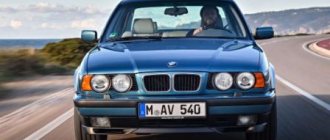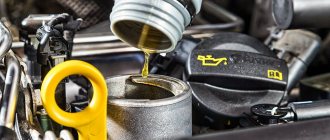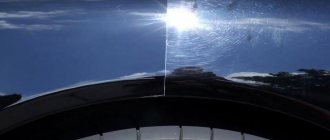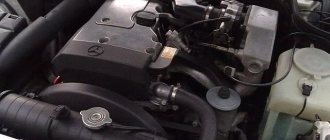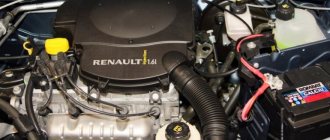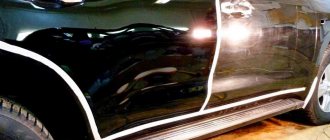Body
What to pay attention to when inspecting the body?!
The car is more than 20 years old, and iron has not stopped corroding in our time, so you must not forget about this and do not hope to find a BMW E34 in an ideal body, at least for little money.
In the 34th body, the first place that begins to rot is the sills, so this is the first place to look and the weak point of the BMW E34. This problem should not be regarded as a drawback, since this is an age-related problem, and it is present on all cars produced in the 90s and earlier.
Externally, the thresholds may still be in more or less normal condition, so in order to understand whether the thresholds have rotted or not, it is necessary to check the internal condition of the thresholds, for example, by hand or by jacking them up and inspecting them in more detail. If the jack is rotten or the owner of the car is against this inspection, decide at your own discretion whether to inspect the car further or not.
First of all, the thresholds are subject to corrosion on the right side, since there are more puddles and dirt on the side of the roadside.
Replacing thresholds is not a cheap job, so think about whether you need such a car or not.
It is also worth considering that a BMW E34 with normally preserved thresholds will be quite difficult to find, since the 34 is not for every car enthusiast a show-off car, it is a car for pleasure, and every owner who respects himself and his car takes care of the car, and that -You need a good reason to break up with her.
As for the wings, just as in the case of the sills, the lower part of the wing suffers first and the factory anti-corrosion peels off; in order to restore its appearance, it must be repaired or completely changed.
In the rear, the fender begins to rot from the bottom up to the gas filler flap. It is worth taking a particularly close look at the lower part of the wing at the junction with the rear bumper. This rotten place cannot be removed by simply painting, and after 6 months it will remind itself again. Therefore, after buying a “five” for yourself, if there is rust in this place, you need to cut out the rotten part of the rear wing and “cook it”. It is not necessary to replace the entire wing, since it is quite enough to thoroughly weld and repaint the affected area.
Often the place under the number on the trunk rots. In the luggage compartment, be sure to inspect the space under the spare wheel and under the trim for the presence of rot.
Inside, the bottom is corroded. From the outside, the bottom of the BMW E34 may seem to be in fairly good condition, but this is only thanks to a thick layer of factory anti-corrosion coating. Most likely, there is enough rust and rot under the carpet, especially if the thresholds have a “sad fate” (especially in niches where water accumulates), since water gets under the threshold and then goes to the bottom where it is absorbed by the upholstery/carpets.
Before purchasing, it is recommended to remove the carpets/upholstery and inspect the condition of the bottom from the inside, since almost every owner sells his ideal, unbeaten, unpainted, garaged car. It is also worth noting that water that accumulates at the bottom of the cabin may well get into the spar, this leads to the fact that the spar begins to rot.
In this garage sits an ideal BMW E34 - unbeaten, unpainted, no mileage in the CIS, one owner, service book... yes, such a thing still exists, but it’s expensive
Perhaps not everyone knows the nuance about the BMW E34, which was supplied from the factory with a sunroof. The fact is that the drains from the hatch pass through the hoses straight into the threshold, and this place can be especially rotten. Therefore, when replacing thresholds, it is imperative to route the drain hoses outside.
In the engine compartment of the body, it is recommended to pay attention to the right side, where the engine control unit is installed, and the left side under the fuse box. At the bottom of the blocks there are drains for water, which become clogged over time, and if these places are not cleaned, the drains become clogged and rotten, as a result of which water begins to flow into the cabin. As practice shows, maintenance of this place is ignored on every second car.
In general, under the hood you need to pay attention to all the body parts. For example, wing reinforcements must be smooth, and if unevenness or traces of welding are noticed on them, then it is immediately clear that this place has been restored. The presence of folds is quite a serious problem, and makes it clear that the body “did not reach the end” and the repair/restoration was not done well.
It is recommended to pay attention to the side members, whether they are level or not, as well as to the presence of rotten places in the engine compartment; it is especially worth inspecting the place under the cups, between the wing and the cup. The condition of the attached parts and the hood itself are also important.
After replacing the windshield, the paint on the body is often damaged, which leads to rust around the windshield. In this case, the restoration of the BMW E34 should be taken more seriously, since this place will rot over time and water will begin to flow into the interior.
On almost all BMW E34s, the lower part of the door rots, from where water drains from the door cavity.
You shouldn't expect to see perfect paintwork on a BMW E34. If the E34 was not completely repainted, then it is quite possible to consider slightly different shades of body paint, for example between the front fender and the door.
Which engine is better to buy a used BMW E34 with?
“Five”: the former thunderstorm of Russian roads is gaining popularity in the used car market. The “angry” assertive appearance of the car is supported by corresponding driving performance
The “Five” BMW of the previous generation (E34 series) appeared in 1988
how much does it cost to replace a generator on a VAZ 2110
VR6 heater doesn't heat well
“Five”: the former thunderstorm of Russian roads is gaining popularity in the used car market. The “angry” assertive appearance of the car is supported by corresponding driving performance
The BMW “Five” of the previous generation (E34 series) appeared in 1988. When the period of accumulation of initial private capital began in Russia in the early 90s, the prestigious German car became the favorite transport of individuals who withdrew the surplus of this very capital. There are probably reasons for this. The Five looks aggressive, is very fast, has a roomy interior and a strong suspension.
In short, an excellent “operational car.” It is not for nothing that folklore deciphers the abbreviation BMW as the Extortionist War Machine. ...Well, those days are gone. Now even drivers of eights and nines fearlessly cut off Bavarian fives, without fear of a forced “road ethics course” conducted using nunchucks and bicycle chains sewn into leather. Now many can go to the car market or go to Europe to buy a BMW “five” at a very reasonable price.
Let us immediately note that we are not considering very old versions of the E34 series. Today we are interested in more recent cars with “plate” engines that have four valves per cylinder. Such “fives” are still considered respectable and prestigious.
If the appearance of the examined “five” suits you, you don’t have to continue further. It is almost impossible to independently assess the state of “health” of a technically complex BMW. But before you take your car for diagnostics, check its criminal record - this is more than relevant for Bavarian cars... Many Russian BMW owners of the mid-90s belonged to the category of people “living for today.” As a result, there are a lot of stolen, uncleared and simply “killed” cars of this brand on the market... First of all, rewrite all the data on the identification plate and check it in the spare parts department of an authorized dealer. There they will tell you whether the VIN number of the car is true and describe the equipment in detail. The VIN number can be found by pressing a button.
If a silver Bimmer with a manual transmission and a velor interior has left the factory, and in front of you is a black car with an automatic transmission and leather, it’s better to abandon such a “five” right away. The car is either assembled from several, or the numbers on it are altered. Then, by all means available to you, check the car for theft and customs “clearance”.
And only after that you can go for diagnostics. But, apparently, fate decided to laugh at the owners of legally pure “fives”. The fact is that the VIN number is also contained in the dashboard computer and is called up by pressing a button, as the priests of the rod and whistle are well aware of. The panel has a tendency to fail, as discussed in the chapter “Electrical Surprises.” A new one is quite expensive, and usually the unsuspecting owner buys a “used” one.
Naturally, a different VIN number is programmed into it. Then the car is stopped at a picket line and... Therefore, if the numbers on the body and the dashboard do not match, it is better to have a forensic examination report with you.
A familiar feature of BMW salons is the center console facing the driver. But air conditioning and power accessories were not mandatory for business class models in the early 90s
BMW starts with the engine. As agreed, we won’t talk about the very old “fives”. We are interested in relatively young specimens with engines with four valves per cylinder. People often call them “slabs”. So, in-line 24-valve “sixes” (M50 series) appeared in 1990
VAZ 2114 troits engine
Two years later, the range of engines was replenished with a 32-valve V8 (M60 series).
Even today, these engines remain the benchmark for power, smoothness and durability. But only subject to qualified service and compliance with operating rules. M50 series Consists of two identically designed engines with a volume of 2 and 2.5 liters, which produce an impressive 150 and 192 horsepower, respectively. It's not just about numbers. The “highlight” of the Bavarian inline sixes is that the driver perceives them as more powerful than they actually are. These motors are very reliable and are considered the most optimal, but you should be wary of overheating, for which there are three reasons.
The first is a radiator simply clogged with lint and dirt. The second is failure due to the advanced age of the fan thermal coupling (replacement costs about $110). Often the plastic impeller of the pump turns on the splines and stops rotating (up to $100).
Having bought a used “five”, immediately make sure that the car does not have the problems described above. It is better to eliminate them immediately. If you miss overheating, the radiator will leak first ($230), and some fans of “steep boiling water” manage to bring the process to the point of deformation of the block head.
Then the repair bill will look so sad that you don’t even want to bring it up. On the move, in-line sixes equipped with the VANOS variable valve timing system are especially good. The car quickly picks up speed from low revs, then the flow of power seems inexhaustible, until the limiter is activated... Bavarian 6-cylinder engines received the VANOS system in 1992.
With a mileage of about 200,000 km, a rumble usually appears in the upper front part of the engine. This means that VANOS requires repair or replacement, which costs $300-600. At this mileage, as a rule, it is time to update the valve stem seals - increased oil consumption will tell you this. Sometimes the cause of the “oil appetite” of an M50 series engine is piston rings that are clogged with low-quality gasoline. They are brought back to life with the help of a special liquid poured into the cylinders.
In 1994, the M50 series was slightly modernized (in particular, the compression ratio was lowered) and received the designation M52. M60 series There are also two V8 engines: 3 liters (218 horsepower) and 4 liters (286 horsepower). Be prepared for a higher cost of engine maintenance and the need to fill the tank with 20-25 liters of gasoline for every hundred kilometers in the city
VAZ 2114 speed fluctuates at idle
True, the pleasure of driving a super-powerful and super-smooth V8 is worth the sacrifice. In M60 engines, spark plugs suffer greatly from our gasoline. They have to be changed after 10,000 km. Sometimes even more often.
You should also install a new auxiliary drive belt along with rollers on time, that is, every 50,000 km (the camshafts on the M50 and M60 are driven by an almost eternal chain). If the belt breaks, it could break the front engine cover, which could save your wallet about $2,000.
szd
From "gourmets".
It needs synthetic or at least semi-synthetic oil. Antifreeze - only branded. It's better not to save money here! Two-faced diesel The “five” was equipped with an in-line 6-cylinder turbodiesel with a volume of 2.5 liters. Excellent in its characteristics, it is very demanding on the quality of diesel fuel. Diesel “fives” come to us mainly from European countries. They were practically never sold new here.
Turbodiesel comes in two versions: “td” and “tds”. In the second case, the engine is equipped with a turbocharger intercooler and therefore develops 143 hp. instead of 115, which is produced by the usual “td”. Both versions are exemplary smooth and quiet. The excellent characteristics of these engines (after all, diesel “fives” are often faster than many gasoline competitors, and compared to diesel “Mercedes” and “Volvos” they seem like sports cars) are achieved due to a high degree of boost. As a result, on domestic, very lousy diesel fuel, the engine often detonates. Hence the increased wear. Servicemen often have to deal with deformed heads and cracks in cylinder blocks.
Of course, cars that have already traveled quite a lot on our roads come to such a state when an engine overhaul costing $2,500-2,700 is required. But if we take into account that diesel engines with low mileage are rare, then even a relatively recently imported car from Europe may require replacement of the turbine, which costs at least $1,500. But regular, approximately every 50,000 km, repair of a high-pressure fuel pump (HPF) costing $700 is almost guaranteed. So, you shouldn’t buy a diesel “five” just for the occasion. A gasoline engine is better. There are only two reasons to purchase a 525td or 525tds. "A" - you are a fanatic of diesel cars. “B” - drive a lot, about 100,000 km per year.
In the latter case, the fuel savings guaranteed by a diesel car will be very noticeable. The sedan's trunk is quite capacious, but keep in mind that the rear seat back does not fold down
Chassis: Don't put off until tomorrow what needs to be replaced today.
To maintain the 5's excellent driving performance, its chassis must always be in good working order. If the required intervention is postponed until later, the machine begins to break down itself. The weakest point in the front suspension is the silent blocks of the upper arms, which, depending on driving style, last 30,000-50,000 km. Replacing them will cost $125. If you delay repairs, you will soon have to replace the lever assemblies, which could last twice as long.
This will cost $245. Do you feel how the car “punishes” its careless owners?.. The steering linkage is usually not replaced entirely at the same time. But play in the steering that is detected during diagnostics must be eliminated immediately. Otherwise, the steering gear will soon start knocking, which is better not to try to tighten - it may “bite” the steering wheel when turning.
It needs to be changed, and finding a working used one is difficult. Apparently, you will have to buy a new one for $1,600-1,800. In the rear suspension, approximately every 80,000-100,000 km it will be necessary to change the axle cross beam supports ($ 110) and shock absorbers along with the upper supports
idle speed sensor vaz 2109 carburetor
The silent blocks of the rear levers require replacement much less often, but - attention and attention again! — with this operation it is better to contact a BMW branded service. This requires knowledge of special technology.
You also need to keep an eye on the wheel bearings. If they buzz or play appears, this is a signal for immediate replacement. Otherwise, you will have to fork out more for the hubs.
Compare: a bearing costs $40, and a hub costs $100. What's the result? If, whenever possible, you use high-quality non-original spare parts and service them at an unauthorized service center that specializes in BMW, then for 100,000 kilometers, investment in the chassis will require about $1,500-2,500. Yes, the amount will have to be paid out gradually, but you can’t count on less.
After reading this chapter, you probably realized that even a new BMW remains a rather expensive car to maintain... A fast, prestigious car designed for a wealthy buyer. Attempts to own a BMW “for free” end with the car becoming “decrepit” very quickly and losing the money spent on its purchase. Electrical “surprises” In the days of its youth, the “five” was a champion in terms of its abundance of electrical equipment and electronic systems. The older the car gets, the more trouble they cause. Most "electrical problems" are age related. If the car is more than seven years old, its electrical wiring has already lost its elasticity and has become brittle and brittle. As a result, contacts in numerous connectors and sensors begin to disappear.
Complex electronic devices are also aging. Our salty winters make a significant contribution to electrical problems. “Electrical problems” can be divided, let’s say, simply into minor troubles and serious breakdowns with which the car cannot be operated. Among the first are the central locking drives, the refusal to open the rear window of the station wagon, the burnt-out electronic board of the instrument panel (it is difficult to restore it, so you have to look for the entire replacement panel). Quite major troubles include the failure of the windshield wiper trapezoid. It costs $220 to change it.
The worst thing is when the ABS or engine control units fail. They are located under the hood in containers with special drainage holes. When they become clogged with dirt and leaves (don't forget to clean the drainage after purchase!), then after a good rain the containers turn into sort of micro-baths. Electronic components splash in the water with all the ensuing consequences. Control “brains” are very expensive.
Finding a used unit is very difficult, since the electronic components of the car were often changed during the production of the model. It is especially difficult to find a used control unit for the “five” equipped with Siemens electronics. As electrical experts say, if you get into a car that is six to eight years old, there will always be work “... worth about three hundred dollars.” So let them find it before buying a car, when they can still bargain with the previous owner. The transmission is an example of reliability. I know that many motorists do not like BMW because of the complex engines that require maintenance. But a powerful engine that instantly picks up speed usually results in a very reliable transmission... The previous owner must truly be a slob in order to “finish off” the elements that transmit the engine’s energy to the wheels. On powerful rear-wheel drive cars, the rear axle gearbox is very sensitive to the quality and level of oil. BMW engineers have provided a special grade. Anything else, even a quality one, is excluded.
Especially if the gearbox is equipped with a self-locking differential. Otherwise, it ends with replacing the gearbox assembly. The same sad result can be achieved if you miss leaking wheel drive seals. which is common on high mileage cars. Without oil, the gearbox will soon hum.
A new one is very expensive, but $200-400 for a used unit is a considerable price to pay for carelessness. Fans of the brand say that a real BMW is one in which the driver changes gears independently
rear disc brakes on VAZ 2114
The mechanical boxes of Bavarian high-speed vehicles are distinguished by excellent precision and reliability. Among the “age-related diseases” we can only mention the loosening of the plastic lever bushing (it can be treated for $70) and the leakage of two oil seals - the shank and the rocker.
Fixing the latter problem will cost approximately $100. By the way, the oil in Bavarian gearboxes is specific; just like in the rear gearbox, it should be changed every 50,000 km. If you are looking at a “five” with an automatic transmission, then we can please you. BMW automatic transmissions are distinguished by the highest reliability. Of course, even the most durable gearbox can be ruined, so before purchasing, carefully inspect the “automatic” so as not to suddenly part with a thousand or two dollars. And again, without fear of seeming like a bore, let me remind you: every 50,000 km you should fill the automatic transmission with branded oil.
Moreover, even such a simple operation is better done at a normal service center that specializes in BMWs, and not where there is a sign “Service for foreign cars of all types.” After all, the Bavarian “automatic”, which not every mechanic knows, is equipped with a filter that must be changed along with the oil. Usually every 50,000-60,000 km knocking and vibration appear when gas is added. They are coming from somewhere under the floor. This requires replacement of the spider or intermediate bearing of the propeller shaft. You can change the bearing separately, but don’t rush to buy a crosspiece - you’ll waste your money.
You can buy it, but installing it and, moreover, balancing it together with the cardan is problematic even with a good service. It is better to buy an assembled driveshaft. It costs $650, but then at 100,000-120,000 km you can forget about the crosspiece.
The sporty “M5” is externally distinguished by a low landing, volumetric spoilers along the lower perimeter of the body and a special design of rims. Station wagons are designated by the word “Touring”. The fifth door, in the American style, can be opened either completely or only the glass can be raised
Main menu dishes and delicacies from the BMW kitchen Most of us are accustomed to the fact that the BMW “five” is a business class sedan or a luxury station wagon, which is designated by the word “Touring”. But this is, so to speak, the main menu. Bavarian cuisine still has exquisite gourmet delicacies... If there is the letter “M” with a three-color chevron on the trunk or radiator grill, this is the first sign of exclusivity. Most likely, the car is equipped with a number of options from the BMW M branded tuning studio - a sports steering wheel, deep seats or a low, rigid suspension that provides increased stability and sharpness of reactions. A rare delicacy is the all-wheel drive version of the 525iX, which was offered in sedan and station wagon body styles, but with only one engine - a 2.5-liter petrol six. This car is not afraid of snow in the yards, and on slippery roads it is very reliable and predictable.
Most of the torque is transmitted to the rear wheels, so the behavior of the car will be familiar to a fan of the BMW brand. It should be taken into account that the all-wheel drive “iX” is more expensive to maintain, since many spare parts for the chassis and transmission will have to be taken only original ones, with the BMW brand. It’s better not to buy a 525iX in Russia - there are very few cars in good technical condition here.
It is preferable to go for a car to some rich mountainous country in Europe, for example, Switzerland or Austria, where all-wheel drive “fives” were popular and where it is easier to find a well-maintained car with a fully functional transmission. But the most exquisite delicacy is the “five” with the index “M5”. Under the hood of such a sedan or station wagon (!) is hidden a 3.8-liter (until 1993, a 3.4-liter “M5” was produced) in-line “six” with a capacity of 340 horsepower. The car can reach a hundred in just 5.9 seconds! Many will say that the 540i with a V8 engine also accelerates quite well, but the driver of the M5 is not fed up with acceleration alone. The car only looks like a business class sedan.
It has a rigid sports suspension of a special design, super-powerful brakes, and special steering. When buying an M5, you need to realize that you are purchasing a sports car that is difficult to drive and expensive to maintain, which is best laid up in winter. No more than $12,000 Considering the previous popularity of the car in criminal circles, do not be surprised by the huge range of prices. You can find a car for $4,000, in seemingly good condition, but... But the dark past of good cheap cars is clear as day. Practice shows that worthy “fives” from the 93-95 edition. are sold for $8,000-15,000 depending on the engine and configuration. Cars costing over $10,000 once again confirm that a legally and technically problem-free Bimmer is worth the money.
When you get behind the wheel of one, you sometimes can’t even believe that the model was discontinued five years ago. Considering that prices for a modern “five” will soon approach fifteen thousand, then for the old one it now makes sense to shell out no more than $12,000
refilling the air conditioner yourself
Of course, if we are not talking about a well-groomed M5.
A car with amazing driving characteristics, which promises to one day become a collector's item, costs completely different money. Codes for the “five” By tradition, the first digit in the index indicates the model. In the second two, the engine volume in liters is encrypted - just mentally put a comma between the numbers. By the way, the method of determining engine volume by index is not applicable to modern “fives”. Thus, the current “540i” has a volume of not four, but 4.4 liters. "523i" has 2.5 liters. The letter “i”, which crowns the index of most petrol “fives”, is a pure atavism.
It began to be used a couple of decades ago to designate prestigious modifications with fuel injection (“i” means “injection”, translated as “injection”). But now in the BMW range there are no cars with carburetors at all. In a word, “i” is a tribute to tradition.
The abbreviations “td” and “tds” denote various turbodiesel options.
Material prepared by Alexander KONOV, photo by Sergei IVANOV and the company, number 16/2000
The editors thank those (tel.: (095) 485-5505) for the provided car and assistance in preparing the material
Published with the kind permission of the Klakson newspaper. This HTML version was created by the authors of the site prostoauto.holm. Use of materials only with the permission of the site administration.
what to look for when buying a Volkswagen Passat V5
buy car glass heating
what does piercing a candle look like?
Similar articles:
Useful tips → Secret letters in your car
Helpful tips → How to properly drive over a speed bump
Useful tips → Winter driving rules
Useful tips → How to protect your car and property from theft?
Useful tips → How to get out of a skid correctly
Engine
The BMW E34 was equipped with 4-, 6- and 8-cylinder petrol and 6-cylinder diesel engines with a volume of 1.8 to 4.0 liters.
Regarding the 34 with the 1.8-liter M40 / M43 (518i) engine, considering that you “caught” a well-maintained copy, in the future this engine will most likely upset you due to the lack of dynamics, which is directly related to the engine, which is rather weak for a five. It is also worth noting that a 1.8-liter version with natural gas (518g) was available, but this model is quite rare, since their production was limited (298 copies and only Touring).
The most popular in the CIS countries are the BMW E34 with 2.0 and 2.5 liter M50 engines. The engine has proven itself reliably over 20 years, subject to moderate loads and proper maintenance.
Particular attention should be paid to the 2.5-liter M50 engine without VANOS. To extend the service life of the engine, it is recommended to change the oil on time (every ~8-10,000 km), air filters and not to overheat the engine.
The restyled versions were equipped with the M50 engine with the VANOS system, the dynamics are a little better, and the consumption is more economical, but all this depends on the technical condition, and today this point practically does not play an important role.
The most significant factor is the condition of the motor. As mentioned above, the “youngest” copy is more than 20 years old, and taking into account the quality of repairs, vehicle maintenance, and driving style, the reliability of the engine decreases, be it the diesel M21 for 524td, M51 for 525td/525tds or gasoline V8 - M60 for 530i/540i .
When inspecting the engine during operation, special attention must be paid to its operation. For example, in an engine with high mileage, there may be a distinct sound of hydraulic compensators clicking, and the cause of these sounds may also be untimely oil changes. The problem with hydraulic compensators can be corrected by flushing if the sound disappears when the engine temperature rises to normal, otherwise it will most likely need to be replaced.
Check the operation of the viscous coupling. The fan is connected to the engine through a viscous coupling, and the viscous coupling is blocked by heat, as a result of which when the engine is warm, the fan should not spin freely.
Engine repair “pleasure” is quite expensive, so high-quality diagnostics are perhaps not recommended, but mandatory, especially if you are planning to buy a BMW E34 with a V8 (530i/540i).
In general, there will be no problems with the engines, the main thing is its condition, since the pre-restyling 535i with the M30 engine may well please and work for a long time if you use the BMW E34 wisely or restore it after “unfortunate riders”, but this is a personal decision for everyone.
Model power units
In Europe, the third generation sedan of the fifth series was presented with a wide selection of power units:
| Engine | Car model | Volume, cubic cm. | Maximum power, l. With. | Fuel type | Average consumption |
| М40В18 | 518i | 1796 | 113 | Petrol | 8,7 |
| М20В20 | 520i | 1990 | 129 | Petrol | 10,3 |
| М50В20 | 520i | 1991 | 150 | Petrol | 10,5 |
| М21D24 | 524td | 2443 | 115 | Diesel | 7,1 |
| М20В25 | 525i | 2494 | 170 | Petrol | 9,3 |
| М50В25 | 525i/iX | 2494 | 192 | Petrol | 10,7 |
| М51D25 | 525td/tds | 2497 | 143 | Diesel | 8,0 |
| М30В30 | 530i | 2986 | 188 | Petrol | 11,1 |
| М60В30 | 530i | 2997 | 218 | Petrol | 10,5 |
| М30В35 | 535i | 3430 | 211 | Petrol | 11,5 |
| М60В40 | 540i | 3982 | 286 | Petrol | 15,6 |
Let's look at the most popular engines.
М40В18
The first in-line 4-cylinder gasoline engine of the M 40 family. They began to be equipped with cars in 1987 as a replacement for the outdated M 10 engine.
The unit was used only on units with index 18i.
- Cast iron cylinder block;
- 8-valve head with single camshaft;
- Thanks to hydraulic compensators, there is no need to adjust the valves;
- Belt drive of the gas distribution mechanism.
According to expert reviews, this unit is rather weak for a five. Despite the economical fuel consumption and the absence of problems with increased oil consumption, drivers note the lack of dynamics inherent in the cars of the series.
The timing belt requires special attention. Its resource is only 40,000 km. A broken belt is guaranteed to bend the valves, so maintenance regulations should be followed.
With careful operation, the engine life exceeds 300,000 km.
It is worth noting that a limited series of engines with a similar volume running on a gas mixture was produced. A total of 298 copies rolled off the assembly line, which were installed on the 518 g model.
М20В20
The engine was installed on BMW 5 Series cars with the index 20i. The engine was produced between 1977 and 1993. The first engines were equipped with carburetors, which were later replaced by an injection system.
Among car enthusiasts, due to the specific shape of the collector, the engine received the nickname “spider”.
Distinctive features of the unit:
- 6-cylinder in-line engine;
- Cast iron block and aluminum head for 12 valves;
- Gas distribution mechanism with one shaft and belt drive;
Due to the lack of hydraulic compensators, it is necessary to adjust the valves at intervals of 15,000 km.
The main disadvantage of the installation is the unfinished cooling system, which has a tendency to overheat.
Power 129 l. With. - a weak indicator for such a heavy car. However, it is perfect for lovers of leisurely trips - quiet operation allows you to significantly save fuel.
М50В20
The engine is the smallest inline six. Serial production was launched in 1991 as a replacement for the M20V20 power unit. The modification affected the following nodes:
- Four valves per cylinder instead of two;
- Two camshafts operating on the DOHC system;
- A phase shifter mechanism was introduced on the intake shaft - VANOS;
- Timing chain drive;
- Modernization of the ignition system - it has become electronic, with a separate coil for each spark plug.
The main difficulties in operation are associated with malfunctions of the ignition coils and injectors, which become clogged when using low-quality gasoline. Approximately every 100,000 you will have to change the valve stem seals. Otherwise, increased engine oil consumption may occur. Some owners are faced with malfunctions of the VANOS system, which can be solved by purchasing a repair kit.
Despite its age, the engine is considered one of the most reliable. As practice shows, with careful handling, the service life before overhaul can reach 500-600 thousand km.
М21D24
Diesel inline six with a turbine, developed on the basis of the M20 gasoline engine. It features an aluminum overhead camshaft head. The power supply system is equipped with a distribution-type injection pump manufactured by Bosch. To control the injection there is an electronic control unit ME.
In general, the unit is considered quite reliable without any problems in operation. Despite this, the engine was not popular with owners due to its low power.
М20В25
Gasoline inline six with fuel injection system. It is a modification of the M20V20 engine. Installed on 5 Series BMW 525i cars in the E 34 body. Features of the unit:
- Updated Bosh Motronic injection system;
- The cylinder diameter has been increased from 80 to 84 mm;
- Crankshaft with increased stroke (75 mm instead of 66);
- Extended connecting rods – from 130 to 135 mm;
- Timing belt drive with a service life of 50,000 km.
The main advantages of the engine are good service life and excellent dynamics. Acceleration time to 100 km/h is 9.5 seconds.
Like other models in the family, the motor has problems with the cooling system. In the event of a malfunction, the engine can easily overheat. In addition, after 200-250 thousand kilometers the cylinder head will have to be changed due to wear on the camshaft beds.
М50В25
A representative of the new family, which replaced the previous model. The main changes concern the cylinder head - it was replaced with a more modern one, with two camshafts for 24 valves. In addition, the VANOS system was introduced and hydraulic compensators were installed. Other changes:
- Timing chain drive;
- Engine torque and noise have been optimized;
- Reduced fuel consumption and reduced toxicity;
- An electronic ignition system has been introduced;
- Bosch Motronic 3.1 control unit.
The unit inherited problems and difficulties in operation from its predecessor.
М51D25
Modification of a diesel unit. The predecessor was accepted by car enthusiasts without much enthusiasm - the main complaints concerned low power. The new version is more dynamic and has increased power – this figure reaches 143 hp. With.
The engine is a straight six with an in-line arrangement of cylinders. The cylinder block is made of cast iron, and its head is made of aluminum. The main changes concern the gas recirculation system and the operating algorithm of the high-pressure fuel pump.
М30В30
The engine was installed on BMW 5 Series cars with the index 30i. This line is considered the most successful in the history of the concern. The engine is a 6-cylinder in-line unit with a volume of 3 liters.
A distinctive feature is a gas distribution mechanism with a single shaft. Its design did not change during the entire period of production of the engine - from 1971 to 1994.
Among car enthusiasts it is known as the “Big Six”.
The problems are no different from the larger brother of the line - M30B35.
М30В35
A large-capacity in-line six petrol engine, which was installed on BMW cars with the 35i index.
The engine differs from its older brother - M30V30 - by an increased piston stroke and a larger cylinder diameter. The gas distribution mechanism is equipped with one shaft for 12 valves - 2 for each cylinder.
The main problems with engines are related to overheating. This is a common disease of 6-cylinder units from the German manufacturer. Failure to correct faults in a timely manner can lead to disruption of the cylinder head plane, as well as the formation of cracks in the block.
Despite the fact that this power unit is considered outdated, many car enthusiasts prefer to use this particular model. The reasons for the choice are ease of maintenance, good engine life and the absence of any special problems.
М60В40/В30
A striking representative of high-power units was produced from 1992 to 1998. It replaced the M30B35 as an intermediate link between in-line sixes and large V12 engines.
The engine is an 8-cylinder unit with a V-shaped cylinder arrangement. Distinctive features:
- Aluminum block with camber angle 90º;
- Nikasil liners and forged crankshaft;
- Timing belt with two camshafts and chain drive;
- Individual ignition coils;
- Engine management system Bosch Motronic 3.3.
Owners of the M60V40 note an increased level of vibration at idle. The problem is usually solved by adjusting the valve timing. Also, it would be a good idea to check the boat gas valve, lambda, and also measure the compression in the cylinders. The engine is very sensitive to fuel quality. Working on bad gasoline leads to rapid wear of the nikasil.
As practice shows, the service life of the unit is 350-400 thousand km.
In 1992, on the basis of this engine, as a replacement for the M30V30, a more compact version of the V-shaped eight, the M60V30, was developed. The main changes affected the crankshaft - the crankshaft was replaced with a short-stroke one, and the cylinder diameter was reduced from 89 to 84 mm. The gas distribution and ignition systems were not modified. In addition, the electronic control unit remains the same.
The unit also adopted shortcomings in operation from its predecessor.
Transmission
The BMW E34 was equipped with 5-speed manual transmissions:
- ZF (gearbox type S5-16) for 520i with M20 engine;
- ZF (S5-31 D) S5D 260Z – 525td/525tds M51;
- Getrag 221/Typ 220/5 – 221/5 (S5D 200G) – 520i M50;
- Getrag 220/Typ 220/5 (S5D-250G) – 520i M50;
- Getrag 240/5 (S5-16) for 518i M40 and 520i M20;
- Getrag 260/5 on 520i M50, 525i M20/M50 and 524td with M21 engine;
- Getrag 260/6 on 530i M30, 535i M30;
- ZF S5-31 (S5D 310Z) – used on 525i/525iX M50, 530i M60;
The 6-speed manual Getrag 226/6 (Typ 226 ASG / S6S 420G / Getrag 420G) was only available for the BMW 540i M60.
Automatic transmission:
- A4S 270R – on 518i M40, 525td M51;
- A4S 310R – on 518i M43, 520i/525i M50;
- ZF 4HP-22 with hydraulic control – 520i/525i M20, 530i M30, 535i M30 and 524td M21;
- ZF 4HP-22/EH with electronic control combined with the Motronic engine management system – 520i and 525i;
- ZF 5HP-18 (A5S 310Z) – 520i/525i/525iX M50, 530i M60 and 525tds M51;
- ZF 5HP-30 (A5S 560Z) only for 540i E34;
When choosing 34, it is recommended to buy a car with a manual transmission. They are more reliable, cheaper to maintain and consume slightly less. But, if you have the opportunity to buy a BMW E34 with a good automatic transmission, buy it. The main thing in the future is to “use it wisely” if the car is bought for yourself, and not for “show-off”.
Pay attention to the travel of the gearshift handle if the E34 is equipped with a manual transmission. If the play is large, this indicates a loose rocker, which can cause some inconvenience later during the trip.
In general, BMW E34 gearboxes are reliable, but again, it all depends on its operating history, loads and quality of service.
What oil to use for the BMW E34 engine
Original
Owners of used BMW E34s buy original motor oil with LongLife 01 approval, which replaced the outdated LongLife 98 in 2001. The fluidity of the lubricant must be selected depending on the operating conditions. For example, SAE 20W-40 or 25W-50 should be used mainly in hot weather, and 0W-30, 0W-40 or 5W-30 is more suitable for winter use. If the car is used all year round, then you can opt for all-season oil with a viscosity of SAE 10W-30, 10W-40 or 5W-40.
Also read: Motor oil for Chevrolet Cruze engine
Unoriginal
When choosing an analogue oil for a BMW E34 car engine, you should focus not only on the reputation of the manufacturer (Shell, Kixx, Mannol, Valvoline, Motul, Castrol, Liqui Moly, Mobil, etc.), but also the characteristics of the product - for example, suitable API clearance. Let's look at it using the example of a 1988 BMW E34 petrol car. So, in this case, the optimal choice would be API-SG. The oil should be all-season mineral with a viscosity of 10W-30. For cars of later years, for example 1996, semi-synthetics with API-SG approval are recommended. Below are the options for the best aftermarket motor oils for the BMW E34.
Suspension
The front suspension is independent, with hydraulic shock absorbers, coil springs, wishbones. The rear suspension is independent, wishbone and consists of inclined arms, telescopic shock absorbers, and anti-roll bar.
The suspension of the BMW E34 is cast iron and quite reliable, but this does not mean at all that it is impossible to “roll it out”.
A quick inspection of the suspension can be carried out while jacking up the car to inspect the thresholds of the BMW E34 and check the condition of the bottom.
You should start by scrolling the wheel; free rotation will give you an idea of the condition of the bearing, which should not make a “rusting” sound. If the calipers are stuck, the wheel will not rotate freely.
In a raised state, check the suspension by shaking the wheel in different directions; this procedure will allow you to preliminarily determine the condition of the suspension. The absence of play indicates that the suspension is in fairly good condition.
On the rear suspension, pay attention to the gum lager and its fastening. Over time, the mount rots and the rear beam begins to float. The condition of the gum lager itself is also important, since if it cracks, problems with the suspension will appear over time.
In any case, high-quality diagnostics will clarify the situation, and quite possibly become a good reason for bargaining.
Four-wheel drive
The BMW E34 with all-wheel drive was produced with only one engine – the 2.5-liter M50 (525iX) in sedan and touring body styles.
The peculiarity of all-wheel drive from BMW in this particular body is the weight distribution of traction forces of 38% on the front axle and 62% on the rear, but redistribution of up to 50% to 50% is possible.
The car is structurally different from rear-wheel drive models - slightly in the body, the angle of the pillars, the cups have a different shape (more similar to the BMW E39) and, of course, the all-wheel drive system.
When driving on the highway, the cars do not differ much, and when purchasing an all-wheel drive E34, it is worth considering the additional costs of servicing the transfer case.
